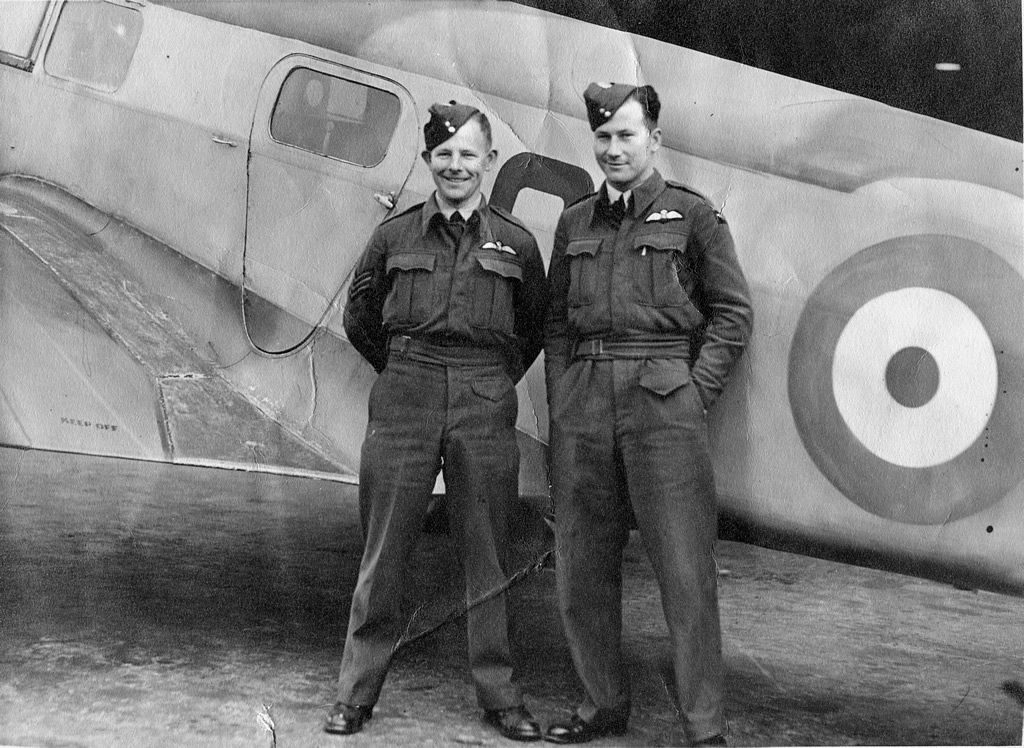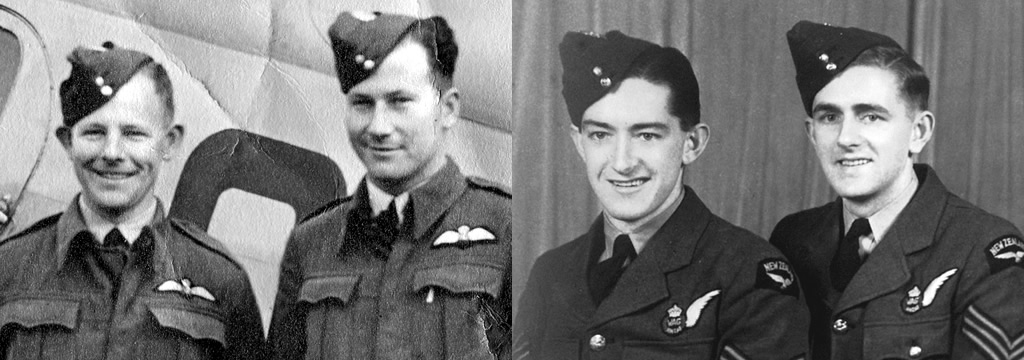In April 2014, Gerry’s son Phil sent through another batch of photos that he had found in his Dad’s stash.
Amongst them was a happy portrait of Gerry and two of his W/Op mates, with signatures and two very sad footnotes added by Gerry.

– Gerry Newey collection, thanks to Phil & Bruce Newey.
A quick Google confirmed the facts. Rex Furey and Ernest Armstrong had gone through Wireless Air Gunner (WAG) training in Canada with Gerry – they were in the same class at No. 3 Wireless School, Winnipeg and at No.2 Bombing & Gunnery School, Mossbank.
The photo above was probably taken in Canada during their pre-embarkation leave; all three proudly wearing their new Sergeant’s stripes and RNZAF WAG brevets (half-wing badges).
Both Rex and Ernest can be seen in Gerry’s No.3 Wireless School graduating squadron class photo:

Rex 2nd from left, back row. Ernest 4th from left, middle row. Gerry centre front row.
– “W.A.G. Mag”, September 1943 issue
And Ernest can be seen in Gerry’s graduation dinner photo:

Gerry 4th from left, this side of nearest table. Ernest 4th from right, other side of the table.
– Gerry Newey collection, thanks to Phil & Bruce Newey.
Sadly, within a year, both had been killed – Rex on his final training flight, and Ernest on one of his first operations.
Rex’s death had a particularly tragic significance.
In October 1944, while Gerry and his crew were on their Heavy Conversion course at 1657 HCU, Stradishall in England, Rex was on a similar Heavy Conversion course at 1651 HCU, Wratting Common.
On the 19th of October 1944, on a low-level cross country navigation exercise, his Stirling LK488, QQ-E crashed into a mountain in fog. Mickle Fell is a 2585 feet high peak in the Pennines range, the highest point in Yorkshire.
The mostly-RNZAF crew were all killed, except for the Rear Gunner, Alan Small.
F/Sgt Rex Patrick Furey, NZ428189 R.N.Z.A.F. Wireless Operator, age 21.
18/19 October 1944: Stirling III LK488, QQ-E, 1651 Heavy Conversion Unit RAF Wratting Common, low-level cross country navigation exercise, their last training flight before being posted to an operational squadron. Off-track and in poor visibility (widespread fog) collided with the top of Mickle Fell (some seven miles ENE of Appleby-in-Westmoreland). Rear Gunner W/O Alan G Small of Takaka, New Zealand, was the only survivor.
Rex came from Okaiawa, the same tiny Taranaki dairy-farming area where Gerry was born, although Gerry’s family had moved north to Auckland while he was still a small child.
Now for the ‘spooky’ part …
Back in November 2012 Johnny Wood’s daughter Debbie had sent me some of his photos for scanning. Among them were several of Johnny with mates during pilot training in New Zealand at No.1 Elementary Flying Training School (1 EFTS), Taieri, then later at No.2 Service Flying Training School (2 SFTS), Wigram.
One guy seemed to be in all of them, including this one of just him and Johnny – they were obviously good mates:

– Debbie Van Beurden
In January 2018, during our search for the mysterious, hospitalised “Buzz” mentioned in Gerry’s diary, I came across a newspaper item with a list of Johnny’s graduating class, pilots who passed out from training at RNZAF Wigram on 29 July 1943.
I realised that the names of the guys in Johnny’s photos were probably in that same list of graduates:

– Papers Past
So I worked my way through the 46 names to see if I could find a photo, either on the AWM Online Cenotaph or in a Google search, that matched a face. Nothing, nothing, nothing, … and then, the last name on the list:

– AWMM Online Cenotaph
Peter Dawbarn Young, from Castor Bay in Auckland. We had found our man, but my heart sank when I saw “killed on active service’.
Next I Googled his name, and sure enough, there was a web page dedicated to he and his crew, killed in a cross-country training flight in England, while at 1651 Heavy Conversion Unit, on 19 October 1944: http://aircrewremembered.com/young-peter.html
Peter Young was Rex Furey’s skipper!
Johnny and Gerry’s good friends were killed in the same crash and they would have found out while together at Stradishall – perhaps they shared more of a bond than we had realised?
Footnote
By complete coincidence, in July 2018 I was contacted by Alastair McFarlane, an aviation archaeologist who lives near Mickle Fell, visited the crash site in the 70s and researched the crew. Having seen one of my Bomber Command posts on Facebook, he thought the New Zealand connection may have been of interest to me – little did he know!!
The aircraft (LK488) was/is the most complete Stirling wreckage left, and no other Stirling has survived or been restored. It was a popular destination for aviation archaeologists back then.
Alastair:
“In 1973, a friend and I went up to Mickle Fell and visited the wreckage. It was amazing, just from one crater a complete tailplane and rear fuselage could have been rebuilt. The mid-upper and rear turrets were there, undercarriage legs, tyres, engines and god knows what else in other holes. I was so taken by the extent of the wreck that I decided to research the background to the crash. This led me to the one survivor, Alan Small the rear gunner. I traced him to running a Shell garage in Coromandel, North Island. He wrote me a very nice letter explaining what happened on the night LK488 crashed and his subsequent survival.
I wrote an article for our local newspaper about the trip to the wreck and the finding of a Browning .303 machine gun (which was identified as having come from the rear turret). A lady contacted the paper to say that she had been married to Alan Small after the war and she still lived in York, not far from me! I went to see her and she told me that Alan’s son was coming to the UK for a visit, so I arranged to meet him and have a photo of him holding one of his father’s guns.”

– Alastair McFarlane.

– Alastair McFarlane.
Alastair sent his research on the crash and wreckage to the RAF Museum in Hendon. In 1977 they arranged for the wreckage to be helicoptered off the hill and placed in storage at RAF Henlow, where it still sits, hopefully to be restored one day.
More about the crash and wreckage here: www.yorkshire-aircraft.co.uk/aircraft/planes/dales/lk488.html
The crew are buried in Stonefall Commonwealth Forces Cemetery, near Harrogate in Yorkshire, about 25 miles from Alastair, and he kindly sent me photographs of Peter and Rex’s headstones.

– Alastair McFarlane.
We Will Remember Them

